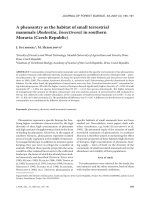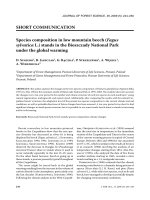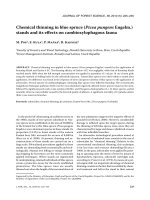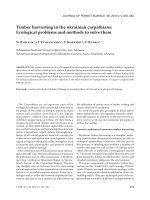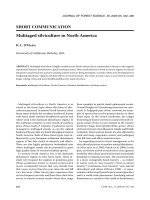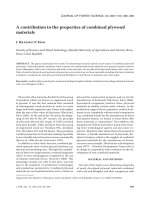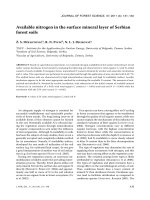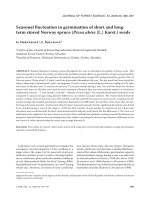Báo cáo lâm nghiệp: "A change in structural diversity and regeneration processes of the spruce virgin forest in Nefcerka NNR (TANAP) in relation to altitude" docx
Bạn đang xem bản rút gọn của tài liệu. Xem và tải ngay bản đầy đủ của tài liệu tại đây (265.2 KB, 9 trang )
J. FOR. SCI., 54, 2008 (12): 545–553 545
JOURNAL OF FOREST SCIENCE, 54, 2008 (12): 545–553
e majority of stands in the 7
th
forest vegetation
level should fulfil difficult ecological functions, the
soil protection and hydrological ones in particular.
A significant part of spruce stands in this forest veg-
etation level preserves the character of the natural
forest.
Long-term monitoring of natural forests of this
forest vegetation level has revealed so far remarkable
differences in the process of developmental stages,
in the dynamics of forming the stand structure de-
pending on altitude (K 1989, 1995). e author
found out that the permanently open crown canopy
of the spruce virgin forest is typical of altitudes above
1,400 m (NNR Chopok, Kosodrevina, Babia hora).
e change in the structure of spruce natural forests
is significantly modified by climatic conditions. e
quantification of diversity through mathematic for-
mulas allows us to evaluate this problem objectively
and to understand better the relations of a given for-
est ecosystem. A remarkable part of their diversity
is the structural diversity, which, according to some
authors, is defined as the composition of biotic and
abiotic components in forest ecosystems (L et
al. 2000), specific arrangement of the components
in the system (G 1999) or as their positioning
and mutual connections (H 1982 in L
1999). According to Z (1999), the structure
can be characterized horizontally, i.e. the spatial
distribution of trees, and vertically in their height dif-
ferentiation. L (1999) adds to these attributes
the amount and the form of dead wood. e hori-
zontal distribution of trees in the space is factually
described by C & E index (1954).
Concerning a different point of view there are some
indices that describe diameter, height or volume dif-
ferentiation (F 1995) or complex indices de-
scribing more components of the structural diversity
(P 1996, 1998; J, D
Supported by the Slovak Research and Development Agency of the Ministry of Education of the Slovak Republic, Project
No. 0082-06.
A change in structural diversity and regeneration
processes of the spruce virgin forest in Nefcerka NNR
(TANAP) in relation to altitude
J. P, M. S
Faculty of Forestry, Technical University in Zvolen, Zvolen, Slovakia
ABSTRACT: is report assesses the structural diversity of the spruce virgin forest in Nefcerka NNR in the Tatra National
Park (TANAP). e structure of the virgin forest is evaluated by the indices proposed by Clark & Evans, Füldner and Jaehne
& Dohrenbusch. Concerning the spatial distribution of trees (Clark & Evans index), a statistically signicant dierence was
conrmed between the growth stage and the optimum and the breakdown stages. e inuence of altitude on the tendency
of concentration of virgin forest trees was also conrmed. In the case of complex diversity evaluation by the J & D-
index (1997), a statistically signicantly dierent diversity of the spruce virgin forest between the growth stage
and the other stages was found. e analysis of the regeneration processes revealed their good dynamics even at an altitude
above 1,400 m, and with the ascending altitude (above 1,300 m) the dead wood and knolls of wind-thrown roots have the
greater importance as seedbeds.
Keywords: spruce virgin forest; structural diversity; regeneration processes
546 J. FOR. SCI., 54, 2008 (12): 545–553
1997; Z 1999; L et al. 1999). By their
help it is possible to add other hierarchical levels of
the stand diversity.
Selected indices for the description of structural
diversity were used in the research of the spruce
natural forest in Babia hora NNR (V et al.
2006). In the altitudinal range of 1,260–1,460 m, on
the series of 57 circular sample plots of 5 ares each,
its structural diversity and regeneration processes
were studied. Concerning the spatial distribution
of the trees in the virgin forest, no tendency of their
clustering in connection with altitude was found in
the zones below 1,460 m. e influence of altitude
was confirmed in the zone above 1,461 m where the
groups of “family spruces” are typical. Diameter dif-
ferentiation was statistically significantly higher in
the growth stage. Evaluation of this attribute in terms
of altitude detected significant differentiation at an
altitude below 1,260 m in the growth stage. Accord-
ing to the Füldner index, it was found out that the
virgin forest has a generally medium differentiated
diameter structure. According to the J and
D index (1997), the differentiation of
the virgin forest decreases with the ascending alti-
tude up to 1,460 m, where the compact forest ends.
e average value for the entire reserve (B = 7.5)
posted this spruce virgin forest to the height differ-
entiated stands with uneven structure. e highest
value was found out in the growth stage (11.5) and
in the breakdown stage (11.8) at an altitude below
1,260 m. e structure of the virgin forest is very
heterogeneous in this altitudinal zone.
e number of the individuals from natural re-
generation (individuals of the height below 130 cm)
is declining in all stages of the virgin forest with the
increasing altitude. is is caused by worse ecologi-
cal conditions and lower fructification of the trees.
Evaluation of the seedbed revealed that 46.2% of
the naturally regenerated individuals were growing
on the soil, 52.4% on dead wood and 1.4% on wind-
thrown roots. Regarding the developmental stages of
the virgin forest, 46% of the individuals were found
in growth stage, 23% in optimum stage and 31%
in breakdown stage. According to K (1989),
V (2005), S (2002, 2007), the portion of
individuals from natural regeneration on dead wood
is increasing with the ascending altitude, the most of
them being in the initial phase of the growth stage.
Conditions of spruce natural forests in NNR in
Slovakia are highly variable. e phenomenon men-
tioned influences their different structures.
e objective of this report is to describe the struc-
tural diversity and dynamics of regeneration proc-
esses of the spruce natural forest in Nefcerka NNR
in Tatra National Park on the basis of 27 research
plots of 5 ares in size that were established in various
stages of the natural forest developmental cycle (3)
and at various altitudes (3 levels).
MATERIAL AND METHODS
e Nefcerka Valley (Nefcerská dolina) is located
at 49°10' of north latitude and 19°59' of east longi-
tude, between the Kriváň massif and the Hrubô ridge
on a rocky slope of south-west aspect. e bedrock is
built of granite rocky mantle rock. Present soil types
are: humus brown forest soil with gley at the bot-
tom, humus iron podzol and ranker (K 1989).
ese soils are clay at the top, sand-clay in lower
parts, highly gravelled, well-aerated and they leak
water very well. ey are acid or very acid, with great
stocks of humus and with the lack of easily accessible
nutrients. e average annual temperature reaches
about 2–2.5°C and the average annual precipitation
is 1,200–1,300 mm.
In the Nefcerka Valley, 27 circular sample plots
were established and stabilized in three altitudinal
categories (up to 1,300, 1,300–1,400, above 1,400 m
a.s.l.). In each category, there were 9 plots, 3 in each
developmental stage of the natural forest (growth
stage, optimum stage and breakdown stage). Each
plot has a constant surface of 500 m
2
, which fully
complies with statistical principles of sampling
optimization (Š 1968, 2000; M et al.
2001). It is used in a standard way for research of
mountain forests (M et al. 2003; V
2005). On a sample plot, we recorded the individu-
als of diameter d
1.3
above 2 cm. For each individual,
the following set of basic attributes was found out,
which is necessary for the complete description of
the stand structure:
• type of tree.
• diameter d
1.3
(cm, to the nearest 1 mm),
• height (m, to the nearest 0.5 m),
• height to crown base (m, to the nearest 0.5 m),
• parameters of crown projection – four dimensions
in two perpendicular directions (m, to the nearest
0.1 m),
• tree location – azimuth (in grades) and distance
(m, to the nearest 0.1 m) from the centre of the
plot.
In this measurement, Field-Map technology was
used.
To characterize the structural diversity of stands
on individual sample plots, we used, apart from the
quantification of basic dendrometric attributes, the
following structural indices: C and E in-
dex (1954) or so-called aggregation index, F
J. FOR. SCI., 54, 2008 (12): 545–553 547
index (1995), so-called index of diameter differentia-
tion and J and D index (1997),
so-called complex stand diversity index. eir de-
scription can be found in the paper by V et
al. (2006). e individual indices were assessed by
means of two-factor analysis of variance, where the
two factors were represented by developmental stage
and by altitude. en Tukey’s test followed. It helps
us to find out pairs of individual factors which were
significantly different.
Regeneration processes were assessed on each
sample plot on 10 small circular sample plots of
10 m
2
(100 m
2
). e first one was in the centre of
the sample plot and the others were established in
a systematic way in the regular distance around the
centre of the sample plot. e evaluated individuals
were classified according to the stand type, height
category (up to 20, 21–50, 51–80, 81–130 and above
131 cm) and the seedbed where they grew (soil,
wind-thrown roots and dead wood).
RESULTS
Structural diversity
The evaluation of the horizontal diversity by
Clark & Evans index in relation with the altitude and
developmental stage of the virgin forest is shown in
Table 1 and in Fig. 1.
Based on an analysis of the plots of the spruce
virgin forest representing the growth stage we can
state that the spruce, as a basic tree species, has
a tendency of clustering with the increasing altitude
(Fig. 1). At an altitude of 1,300 m, the index was
1.032 ± 0.033, which documents a random distribu
-
tion of trees on the plot. e value decreased with the
ascending altitude and in the height category above
1,400 m, the index was 0.732 ± 0.103 (Table 1).
ere is a remarkable difference in the values of
Clark & Evans index between the plots representing
the optimum and the breakdown stages. e analysis
Table 1. Average values of Clark & Evans, Füldner and Jaehne & Dohrenbusch indices per altitudinal category and
developmental stages
Altitudinal category Developmental stage Füldner index
Clark & Evans index
Jaehne &
Dohrenbusch index
value T statistics
Up to 1,300 m a.s.l.
growth stage 0.390 ± 0.052 1.032 ± 0.033 0.09–0.92 5.89 ± 0.43
optimum stage 0.307 ± 0.046 1.125 ± 0.035 0.81–1.90 3.23 ± 0.19
breakdown stage 0.258 ± 0.055 1.107 ± 0.084 0.01–1.71 5.29 ± 0.24
1,300–1,400 m a.s.l.
growth stage 0.444 ± 0.040 0.927 ± 0.060 0.21–1.87 6.20 ± 0.33
optimum stage 0.276 ± 0.037 1.006 ± 0.062 0.30–1.19 3.87 ± 0.63
breakdown stage 0.412 ± 0.054 0.939 ± 0.091 0.19–1.27 5.46 ± 1.20
Above 1,400 m a.s.l.
growth stage 0.475 ± 0.053 0.732 ± 0.103 1.93–3.39 7.07 ± 0.56
optimum stage 0.371 ± 0.041 1.079 ± 0.130 0.35–2.39 4.43 ± 0.61
breakdown stage 0.379 ± 0.021 1.040 ± 0.065 0.04–1.06 4.99 ± 0.34
1.4
1.3
1.2
1.1
1.0
0.9
0.8
0.7
0.6
0.5
up to 1,300 1,300–1,400 over 1,400
Clark & Evans index
Stage growth
Stage optimum
Stage breakdown
Altitudinal category
Fig. 1. e results of Clark & Evans
index in individual altitudinal cat-
egories and developmental stages
of the virgin forest Nefcerka
548 J. FOR. SCI., 54, 2008 (12): 545–553
of the plots which characterize the optimum stage in
relation to the ascending altitude does not confirm
its effect. By this attribute of its structure, the virgin
forest behaves in a similar way. e index confirmed
a random distribution of trees in this stage (Fig. 1,
Table 1).
e structure of the spruce virgin forest on the
plots representing the breakdown stage has similar
values of the index like in the optimum stage. A
slight difference was observed just at altitudes of
1,300–1,400 m (Fig. 1). e testing of the values of
R index confirmed a statistically highly significant
difference between the growth stage and the other
stages of the spruce natural forest in the whole height
profile of the virgin forest. e testing of the influ-
ence of the altitude revealed its great influence in the
growth stage. In the optimum and breakdown stages
a statistically significant difference in the index was
confirmed in the spruce virgin forest in the altitudi-
nal range of 1,300–1,400 m.
e analysis of the structure of the spruce virgin
forest in Nefcerka NNR assessed according to the
Clark & Evans index confirmed that trees, regardless
of the altitude, had a random spatial distribution. In
the case of developmental stage, the effect of altitude
was confirmed in the growth stage, where trees had
a tendency of moderate clustering with the ascend-
ing altitude.
Diameter structure of the virgin forest is another
indicator of its structural diversity. In this case, we
analyzed it by means of the Füldner index TM (Fig. 2,
Table 1).
Evaluation of the average value of this indicator
confirmed that the greatest diameter differentiation
can be found in the spruce forest in the growth stage,
which is understandable. On the other hand, the eval-
uation in relation to altitude confirmed the effect of
climate changes. e value of the Füldner index rises
with the ascending altitude and at an altitude above
1,400 m it reaches 0.475 ± 0.05, which represents
the medium level of differentiation (Table 1, Fig. 2).
In the case of the developmental stage, this value
was lower in the optimum stage. Its minimum was
reached at an altitude above 1,400 m: 0.371 ± 0.04. A
stochastic character of this index could also be ob-
served in the breakdown stage, where at altitudes of
1,300–1,400 m it reached the value 0.412 ± 0.05 with
the following fall to 0.379 ± 0.021 (Table 1, Fig. 2).
e testing of the two factors (stage, altitude) con-
firmed that the growth stage, as in the case of trees,
has an influence on the greater diameter differen-
tiation of the virgin forest trees. is differentiation
increases with the ascending altitude.
Information about the complete stand diversity
was assessed by the B J and D
index (1997). Data can be found in Table 1 and in
Fig. 1. If we consider this attribute from the aspect
of the developmental stage of the virgin forest, we
can state that the highest values were found out in
the growth stage and according to the scale outlined
by the authors it is evaluated as a stand with uneven
structure. e testing of this value confirmed that
it is higher, which is statistically very important, in
comparison with the average values found out in
the optimum and the breakdown stages. In spite of
the fact that this value, in the growth stage of this
spruce virgin forest, increases with the ascending
altitude, its influence was not confirmed in testing
(Table 1). An analysis of the general structural di-
versity by means of the J and D
index (1997) confirmed that the structural diversity
of the spruce virgin forest in Nefcerka NNR was
significantly influenced by its developmental stage
and partly also by the altitude. It is the texture of
0.6
0.5
0.4
0.3
0.2
0.1
up to 1,300 1,300–1,400 over 1,400
Füldner index
Stage growth
Stage optimum
Stage breakdown
Altitudinal category
Fig. 2. e values of Füldner in-
dex in individual altitudinal cat-
egories and developmental stages
of the virgin forest Nefcerka
J. FOR. SCI., 54, 2008 (12): 545–553 549
the virgin forest that decides on the degree of its
diversity, and namely the percentage of the overall
area share of this stage as well as the area alternation
with other stages.
Regeneration processes
Information concerning the regeneration proc-
esses in relation to the altitude is shown in Tables
2 to 4. Based on the evaluation of the natural regen
-
eration of spruce from the sample plots at altitudes
up to 1,300 m we can state that its dynamics is good
in each developmental stage. Apart from the spruce
as the basic tree species of the virgin forest, we were
surprised by the great number of rowan-trees practi-
cally in all developmental stages. Its relative propor-
tion ranged between 34.0% in the growth stage up
to 53.2% in the optimum stage. In absolute figures,
in the breakdown stage there were 10,599 individu-
als/ha. e spruce with its number ranging from
5,534 ind/ha in the optimum stage to 12,000 ind/ha
in the breakdown stage forms the base for the gener-
ation succession of this virgin forest. From the aspect
of the height shifts, the most favourable conditions
for the spruce are in the growth and breakdown
stages (Table 2).
e structure of the natural regeneration of the
virgin forest at altitudes of 1,300–1,400 m has bet-
ter indicators (Table 3). The highest number of
individuals was found out in the breakdown stage,
where we recorded 22,067 ind/ha of spruce with its
greatest numbers in the height level up to 20 cm.
ese values represent a nearly double increase in
comparison with the virgin forest up to an altitude of
1,300 m. We were surprised by the number of spruce
individuals in the optimum stage – 13,133 ind/ha,
which was higher than at altitudes up to 1,300 m. On
the other hand, we have to say that its height shift to
higher classes is greatly inhibited by the unfavour-
able ecological conditions which are not suitable
9
8
7
6
5
4
3
2
1
up to 1,300 1,300–1,400 over 1,400
Jaehne & Dohrenbusch index
Stage growth
Stage optimum
Stage breakdown
Altitudinal category
Fig. 3. e values of the com-
plex Jaehne & Dohrenbusch
index in individual altitudinal
categories and developmen-
tal stages of the virgin forest
Nefcerka
Table 2. Tree species structure of natural regeneration (trees/ha) in the altitudinal category up to 1,300 m a.s.l. and
developmental stages
Stage
Tree
species
Height class (cm) Total
up to 20 21–50 51–80 81–130 above 130 N (%)
Growth stage
spruce 4,767 633 233 367 333 6,333 66.0
rowan 2,267 700 267 33 – 3,267 34.0
total 7,034 1,333 500 400 333 9,600 100.0
Optimum stage
spruce 5,067 267 100 100 – 5,534 46.8
rowan 3,033 1,833 900 500 33 6,299 53.2
total 8,100 2,100 1,000 600 33 11,833 100.0
Breakdown stage
spruce 9,633 1,734 200 300 133 12,000 53.1
rowan 2,900 3,066 2,566 1,567 500 10,599 46.9
total 12,533 4,800 2,766 1,867 633 22,599 100.0
550 J. FOR. SCI., 54, 2008 (12): 545–553
for its growth. e values of spruce individuals in
the growth stage are similar to those at altitudes up
to 1,300 m and the dynamics of its shifts to higher
height classes is at a similar level.
e structure of the natural regeneration of the
virgin forest at altitudes above 1,400 m is character-
ized by optimistic results (Table 4). e spruce in
the breakdown stage with its number 7,399 ind/ha
creates good conditions in the long-term develop-
mental cycle (300 years) for generation succession
in spite of the fact that its shift to higher height
classes is inhibited by the plant competition. On the
other hand, we have to state that the high numbers
of rowan individuals – 19,567 ind/ha,
with the good
dynamics of height growth improve, from the long-
term aspect, ecological conditions for the growth of
spruce. e data confirm that the spruce in the op-
timum stage has better ecological conditions for its
height growth, as the virgin forest at this altitude also
has open canopy or canopy with gaps in this stage.
Such a long-term state creates a better ecological
profile for the height growth of spruce. e growth
stage with its differentiated structure disturbs regen-
eration processes from the aspect of the survival and
growth of spruce seedlings.
An analysis of the influence of the seedbed on the
number of spruce and rowan individuals is recorded
in Table 5. e analysis of this factor in the spruce
virgin forest at altitudes up to 1,300 m confirmed
that soil was the prevailing seedbed. In relation to the
developmental stage of the virgin forest, we found
from 5,600 ind/ha (growth stage) to 18,467 ind/ha
(breakdown stage)
of spruce and rowan individuals
on the soil, which accounted for 58.3% to 81.7%.
Lying dead wood with stumps as a seedbed forms
from 9.3% in the breakdown stage up to 19.1% in
the growth stage of the total number of individuals
of natural regeneration.
e natural regeneration structure of the stud-
ied spruce virgin forest Nefcerka at altitudes of
Table 3. Tree species structure of natural regeneration (trees/ha) in the altitudinal category 1,300–1,400 m a.s.l. and
developmental stages
Stage
Tree
species
Height class (cm) Total
up to 20 21–50 51–80 81–130 above 130 N (%)
Growth stage
spruce 5,633 400 166 367 233 6,799 63.2
rowan 2,733 1,000 100 33 100 3,966 36.8
total 8,366 1,400 266 400 333 10,765 100.0
Optimum stage
spruce 12,333 400 166 167 67 13,133 62.6
rowan 5,333 1,867 600 33 – 7,833 37.4
total 17,666 2,267 766 200 67 20,966 100.0
Breakdown stage
spruce 17,833 3,000 567 367 300 22,067 70.9
rowan 1,533 2,133 2,967 1,933 500 9,066 29.1
total 19,366 5,133 3,543 2,300 800 31,133 100.0
Table 4. Tree species structure of natural regeneration (trees/ha) in the altitudinal category above 1,400 m a.s.l. and
developmental stages
Stage
Tree
species
Height class (cm) Total
up to 20 21–50 51–80 81–130 above 130 N (%)
Growth stage
spruce 167 233 167 134 333 1,035 14.5
rowan 1,300 1,300 2,133 1,167 200 6,100 85.5
total 1,467 1,533 2,300 1,301 533 7,134 100.0
Optimum stage
spruce 8,034 300 33 200 – 8,567 44.8
rowan 6,033 3,367 833 333 – 10,566 55.2
total 14,067 3,667 866 533 – 19,133 100.0
Breakdown stage
spruce 6,133 866 333 67 – 7,399 27.4
rowan 4,600 8,467 5,067 1,200 233 19,567 72.6
total 10,733 9,333 5,400 1,267 233 26,966 100.0
J. FOR. SCI., 54, 2008 (12): 545–553 551
1,301–1,400 m is different. e relative proportion of
individuals on the soil was from 46.1% in the growth
stage up to 52.5% in the optimum stage (Table 5). In
all developmental stages at this altitude, the relative
number of individuals on the wind-thrown roots in-
creased as well as the number of individuals of both
trees species on lying dead wood or stumps.
If we evaluate the number of spruces as the main
component of the virgin forest structure at the upper
line of its distribution at an altitude above 1,400 m,
we can state that 56.3% of the spruce individuals
(4,165 ind/ha) can be found on dead wood in the
breakdown stage. On the soil, it is only 1,167 ind/ha
(15.8%). Elevated places of wind-thrown roots par-
ticipate in the regeneration in this stage by 27.9%
(2,066 ind/ha). By an analysis of the seedbed in the
optimum stage having the characteristics of open
canopy it was found out that from the total num-
ber of spruce individuals – 8,566 ind/ha, only
1,800 ind/ha grew on dead wood. Most of the indi
-
viduals – 4,300 ind/ha (50.2%) was found on wind-
thrown roots. A similar situation can be observed in
the growth stage although the value of these data is
not so important, as only 1,035 ind/ha of spruce was
found in this stage. e reason is a substantially low-
er proportion of dead wood in this stage – 2.3% of the
surface of 15 ares, as well as a dense canopy which
leaks less warmth necessary to start the processes of
seedling germination. In the breakdown stage, the
proportion of dead wood is 7.5%. With much better
thermal conditions, it creates better circumstances
for the spruce seedling germination.
We learnt from the analysis of regeneration proc-
esses that at an altitude above 1,300 m, dead wood
contributes to the preservation of the spruce natural
forest by 40.3% up to 56.3% in the breakdown stage.
DISCUSSION AND CONCLUSION
e bedrock of the spruce natural forest in Nef-
cerka NNR in TANAP is built of a crystalline com
-
plex. Its structure is determined to a great extent
by the soil type – ranker soil, which contributes to
the diversity of this virgin forest from the aspect of
irregular nutrient supply. In comparison with the
structural diversity of the virgin forest Babia hora
(V et al. 2006) determined by J and
D index (1997), the structural diver-
sity of the spruce virgin forest in Nefcerka NNR
is slightly lower, in the growth stage even remark-
ably lower. e reason is better soil (flysch) in the
Babia hora NNR, higher number of individuals per
unit area with greater height differentiation hav-
ing nearly a character of unnatural forest structure
(S 2007). In the complex mathematic formula
of J and D index (1997), great
support is given to the vertical structure index.
In the formula, 3 thickest and 3 thinnest trees are
involved, which logically gives lower values of this
complex index with the lower number of trees in
Nefcerka NNR. e information given by the index
concerned is more important for the virgin forests
in lower forest vegetation levels, where the diameter
and height differentiation is greater and tree species
structure is richer. Structural diversity qualified by
the three indices confirmed the highest structural
diversity in the growth stage and its increase with
the ascending altitude.
Regeneration processes, by their dynamics and
seedbed influence on the number of spruce individu-
als, confirmed the existing findings obtained in the
research on the developmental cycle of the spruce
virgin forest Babia hora (H 1998; V
Table 5. Tree species structure of natural regeneration (trees/ha) per altitudinal category, developmental stage and
seedbed type
Altitude
category
Seed bed
type
Growth stage Optimum stage Breakdown stage
spruce rowan
total
spruce rowan
total
spruce rowan
total
N (%) N (%) N (%)
Up to
1,300 m
a.s.l.
soil 2,500 3,100 5,600 58.3 3,333 6,033 9,366 79.2 8,234 10,233 18,467 81.7
windthrow 2,033 133 2,166 22.6 933 266 1,199 10.1 1,800 233 2,033 9.0
dead wood 1,800 33 1,833 19.1 1,267 – 1,267 10.7 1,966 133 2,099 9.3
1,300–
1,400 m
a.s.l.
soil 1,600 3,367 4,967 46.1 4,833 6,167 11,000 52.5 8,134 6,633 14,767 47.4
windthrow 1,667 600 2,267 21.1 4,265 1,500 5,765 27.5 5,033 1,867 6,900 22.2
dead wood 3,533 – 3,533 32.8 4,033 166 4,199 20.0 8,900 566 9,466 30.4
Above
1,400 m
a.s.l.
soil 234 3,833 4,067 57.0 2,466 8,934 11,400 59.6 1,167 15,933 17,100 63.4
windthrow 634 1,666 2,300 32.2 4,300 1,067 5,367 28.0 2,066 2,767 4,833 17.9
dead wood 167 600 767 10.8 1,800 567 2,367 12.4 4,165 866 5,031 18.7
552 J. FOR. SCI., 54, 2008 (12): 545–553
et al. 2006). e higher the altitude, the greater the
importance of dead wood as a seedbed. At altitudes
above 1,400 m, we found out the number of spruce in-
dividuals in the breakdown stage 4,165 ind/ha, which
represents 56.3% of the total number of natural re-
generation individuals. is number is lower than in
the case of NNR Babia hora. However, it confirms the
rising importance of dead wood for the preservation
of generation succession of the spruce virgin forest.
On the other hand, we have to underline a far greater
importance of wind-thrown roots as a seedbed. e
number of individuals on this germination medium
– 2,066 ind/ha (27.9%) in the breakdown stage de-
pends on the ranker soil of this virgin forest. e soil
on the root clusters remains longer and thus creates
a suitable seedbed for the spruce regeneration.
e research of the spruce natural forest NNR Nef-
cerka confirmed that, with the ascending altitude,
the structural diversity increases most in the growth
stage. Regeneration processes are continuous and the
importance of dead wood and wind-thrown roots as
seedbeds grows.
R e f erence s
CLARK P.J., EVANS F
.C., 1954. Distance to nearest neighbour
as a measure of spatial relationship in populations. Ecology,
35: 445–453.
FÜLDNER
K., 1995. Strukturbeschreibung von Buchen-Edel-
laubholz-Mischwäldern. [Dissertation Forstliche Fakultät
Göttingen.] Göttingen, Cuvillier Verlag: 146.
GADOW K
., 1999. Waldstruktur und Diversität. AFJZ, 170:
117–121.
HOLEKSA J
., 1998. Rozpad drzewostanu i odnowienie swierka
a struktura i dynamika karpackiego boru gornoreglowego.
Lodz, Monographie botanicae, 82: 210.
JAEHNE S., DOHRENBUSCH A.,
1997. Ein Verfahren zur
Beurteilung der Bestandesdiversität. Forstwissenschaftli-
ches Centralblatt, 116: 333–345.
KORPEĽ Š
., 1989. Pralesy Slovenska. Bratislava, Veda: 328.
KORPEĽ Š
., 1995. Die Urwälder der Westkarpaten. Stuttgart,
Gustav Fischer Verlag: 310.
LEXER M.J., LEXER W., HASENAUER H.
, 2000. e Use of
Forest Models for Biodiversity Assessments at the Stand
Level. Investigation Agraria, Sistemas y Recursos Foresta-
les. Fuera de Serie A, No. 1: 297–316.
LÄHDE E., LAIHO O., NOROKORPI Y., SAKSA T
., 1999.
Stand structure as the basis of diversity index. Forest Ecol-
ogy and Management, 115: 213–220.
LÜBBERS P.,
1999. Diversitätsindizes und Stichprobenver-
fahren. Freiburg, Universität Freiburg: 101.
MERGANIČ J., VORČÁK J., MERGANIČOVÁ K., ĎURSKÝ
J., MIKOVÁ A., ŠKVARENINA J., TUČEK J., MINĎÁŠ J.,
2003. Monitoring diverzity horských lesov severnej Oravy.
Tvrdošín, EFRA: 200.
MEYER P., ACKERMANN J., BALCAR P., BODDENBERG
J., DETSCH R., FÖRSTER B., FUCHS H., HOFFMAN B.,
KEITEL W., KÖLBEL M., KÖTHKE C., KOSS H., UNKRIG
W., WEBER J., WILLIG J.,
2001. Untersuchung der Wald-
struktur und ihrer Dynamik in Naturwaldreservaten.
Potsdam, IHM-Verlag: 107.
PRETZSCH H.,
1996. Strukturvielfalt als Ergebnis Waldbau-
lichen Handels. AFJZ, 167: 213–221.
PRETZSCH H
., 1998. Structural diversity as a result of silvi-
cultural operations. Lesnictví-Forestry, 44: 429–439.
SANIGA M., 2002. Štruktúra, produkčné procesy a regeneračné
procesy smrekového prírodného lesa v lokalite Krížne
a Nefcerka. Štúdie o TANAPe,
6: 133–151.
SANIGA M
., 2007. Pestovanie lesa. [Vysokoškolská učebnica.]
Zvolen, Technická univerzita Zvolen: 310.
ŠMELKO Š.,
1968. Matematicko-štatistická inventarizácia
zásob lesných porastov. Bratislava, SAV: 299.
ŠMELKO Š
., 2000. Biometrické vlastnosti koncentrických
kruhových skusných plôch, ich koncepcia, reprezentatívnosť,
presnosť, hospodárnosť a praktická použiteľnosť. AFF Zvo
-
len, XLII: 163–178.
VORČÁK J
., 2005. Štrukturálna diverzita vybraných horských
lesov Oravských Beskýd a Západných Tatier vo väzbe
na ich ekologickú stabilitu. [Dizertačná práca.] Zvolen,
Tvrdošín: 135.
VORČÁK J., MERGANIČ J., SANIGA M
., 2006. e struc-
tural diversity change and the regeneration processes of the
Norway spruce natural forest in NNR Babia hora according
to the altitude. Journal of Forest Science, 52: 399–409.
ZENNER E.K.,
1999. Eine neue Methode zur Untersuchung
der Dreidimensionalität in Wald-beständen. Freiburg,
Universität Freiburg: 11.
Received for publication March 12, 2008
Accepted after corrections July 11, 2008
Zmena štrukturálnej diverzity a regeneračné procesy smrekového pralesa
v NPR Nefcerka (TANAP) v závislosti od nadmorskej výšky
ABSTRAKT: Príspevok hodnotí štrukturálnu diverzitu smrekového pralesa v NPR Nefcerka v Tatranskom národnom
parku (TANAP) v závislosti od vývojových štádií a nadmorskej výšky. Štruktúra pralesa sa hodnotí pomocou indexu
J. FOR. SCI., 54, 2008 (12): 545–553 553
Clark & Evans, Füldnera a indexu Jaehne & Dohrenbusch. V prípade rozmiestnenia stromov (index Clark & Evans)
sa potvrdil štatisticky významný rozdiel v štádiu dorastania voči štádiu optima a rozpadu. Potvrdil sa tiež vplyv
nadmorskej výšky na tendenciu koncentrácie stromov pralesa. V prípade hodnotenia komplexnej diverzity podľa
indexu J & D (1997) sa potvrdila štatisticky významne rozdielna diverzita smrekového pralesa
v štádiu dorastania voči ostatným vývojovým štádiám.
Rozbor regeneračných procesov potvrdil, že tieto prebiehajú
v dobrej dynamike aj v nadmorskej výške nad 1 400 m, pričom so stúpajúcou nadmorskou výškou (nad 1 300 m)
nadobúda väčší význam klíčne lôžko moderové drevo a kopčeky po koreňových baloch vyvrátených stromov.
Kľúčové slová
: smrekový prales; štrukturálna diverzita; regeneračné procesy
Corresponding author:
Prof. Ing. M S, DrSc., Technická univerzita vo Zvolene, Lesnícka fakulta, T. G. Masaryka 24,
960 53 Zvolen, Slovensko
tel.: + 421 455 206 234, fax: + 421 455 332 654, e-mail:


